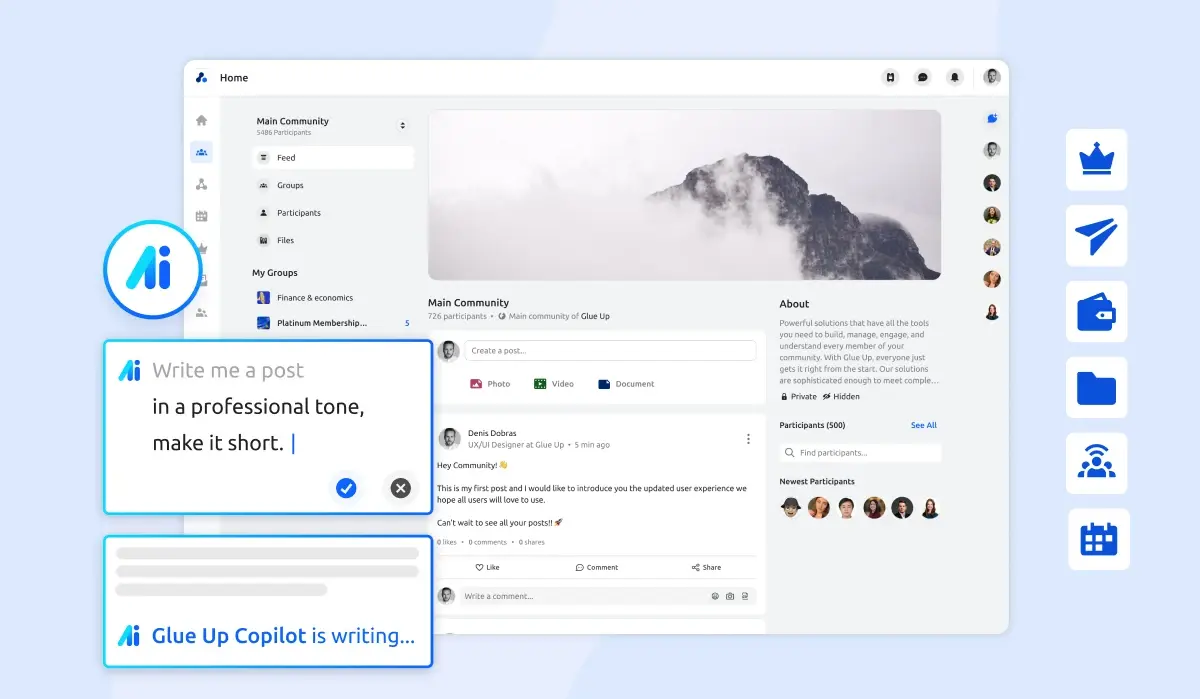
Certificate programs have gained immense popularity among professionals seeking to enhance their expertise and stay competitive in their respective fields. For associations and organizations, offering compelling certificate programs can be extremely beneficial in attracting and retaining members, while also providing valuable educational opportunities.
In this comprehensive guide, we'll explore the process of crafting certificate programs that genuinely excite and engage your members. We'll also review the various types of programs, discuss best practices for creating captivating content, and show you how to leverage Glue Up's powerful software to streamline your program management and delivery.
Key Takeaways
- Certificate programs are highly valued by professionals for career advancement, skill development, and networking opportunities. They offer specialized knowledge in a time-efficient format, making them attractive to busy individuals seeking to enhance their expertise.
- The success of a certificate program largely depends on its content relevance and delivery method. Regular industry trend monitoring and collaboration with subject matter experts are crucial for maintaining up-to-date, valuable content that resonates with participants.
- Practical application of learned concepts is a significant draw for certificate programs. Incorporating real-world examples, hands-on projects, and industry-specific tools can significantly increase the perceived value and immediate applicability of the program for participants.
- Flexibility in learning paths is becoming increasingly important. Offering modular designs, multiple format options, and micro-credentials allows organizations to cater to diverse learning preferences and time constraints, potentially increasing participation and completion rates.
- Technology plays an imperative role in managing and delivering effective certificate programs. Comprehensive software solutions can streamline various aspects of program administration, enhancing the overall experience for both organizers and participants.
Why Certificate Programs are Important for Members

Before we move on to the specifics of creating exciting certificate programs, it's essential to understand why these programs are so appealing to members:
- Career Advancement: Certificate programs offer focused, practical knowledge that can directly impact a professional's career journey.
- Skill Development: They provide an opportunity to acquire new skills or enhance existing ones in a structured, guided environment.
- Networking Opportunities: Participants can connect with like-minded professionals, fostering valuable relationships within their industry.
- Credibility: Certificates from reputable organizations add weight to a professional's resume and LinkedIn profile.
- Time-Efficient Learning: Unlike full degree programs, certificate courses are typically shorter and more focused, making them ideal for busy professionals.
- Specialized Knowledge: They often cover niche topics or emerging trends that may need to be addressed in traditional educational settings.
With these benefits in mind, let's explore how to create certificate programs that capitalize on these advantages and truly excite your members.
Types of Certificate Programs
To cater to diverse learning preferences and schedules, consider offering a variety of program formats. Here are some popular types of certificate programs:

1. Webinars and Virtual Workshops
Format: Live online sessions that typically last 1-3 hours.
Webinars and virtual workshops leverage cutting-edge video conferencing technology to create engaging, real-time learning experiences.
These sessions often feature screen sharing, virtual whiteboards, and breakout rooms to enhance interactivity. Presenters can use polls and quizzes to gauge audience understanding and tailor content on the fly.
Benefits:
- Accessible from anywhere with an internet connection
- Interactive Q&A sessions
- Can be recorded for on-demand viewing
Best For: Introducing new concepts, industry updates, or short skill-building sessions.
2. Live Courses
Format: In-person classes held over multiple sessions or consecutive days.
Live courses create a focused learning environment free from everyday distractions. They often incorporate a variety of teaching methods, including lectures, group discussions, role-playing exercises, and hands-on activities.
The physical presence of instructors allows for immediate clarification and personalized guidance.
Benefits:
- Face-to-face interaction with instructors and peers
- Hands-on learning opportunities
- Immersive experience
Best For: In-depth skill development, practical training, and networking-focused programs.
3. Hybrid Programs
Format: A combination of online and in-person elements.
Hybrid programs blend the best of both worlds, offering the convenience of online learning with the depth of in-person instruction. These programs often use a "flipped classroom" approach, where participants study theoretical content online before applying concepts in face-to-face sessions.
This format allows for more efficient use of in-person time for high-value activities.
Benefits:
- Flexibility of online learning with the engagement of in-person sessions
- Caters to different learning styles
- Allows for both self-paced and structured learning
Best For: Comprehensive programs that require both theoretical knowledge and practical application.
4. Self-Paced Online Courses
Format: Pre-recorded video lessons, reading materials, and assessments that are accessible anytime.
Self-paced online courses utilize adaptive learning technologies to personalize the learning experience. These courses often include interactive simulations, gamified elements, and AI-driven feedback systems to enhance engagement.
Many incorporate social learning features, such as discussion forums or peer review systems, to foster a sense of community.
Benefits:
- Flexibility for learners to complete at their own pace
- Scalable to a large number of participants
- Cost-effective to produce and maintain
Best For: Foundational knowledge, theoretical concepts, and learners with busy or unpredictable schedules.
5. Bootcamps
Format: Intensive, short-term programs typically lasting a few days to a few weeks.
Bootcamps create a high-intensity learning environment that simulates real-world pressure and deadlines. They often employ a project-based learning approach, where participants work on solving actual industry problems.
Many boot camps conclude in a "demo day" or pitch session, where participants present their projects to industry professionals.
Benefits:
- Rapid skill acquisition
- Immersive learning experience
- Often includes project work and peer collaboration
Best For: Accelerated learning of specific skills or technologies, career changers, or professionals needing to quickly upskill.
6. Mastermind Groups
Format: Small, facilitated groups of peers meeting regularly over an extended period.
Mastermind groups foster a unique learning environment based on the collective intelligence of the group. These programs often employ structured problem-solving methodologies, such as design thinking or Lean Six Sigma.
Participants take turns presenting challenges, receiving feedback, and being held accountable for implementing solutions.
Benefits:
- Peer-to-peer learning and support
- Accountability and motivation
- Networking and relationship-building
Best For: Leadership development, problem-solving skills, and fostering long-term professional relationships.
How to Craft Compelling Certificate Programs

Now that we've explored various program types, let's learn about the key elements that make certificate programs truly exciting for members:
1. Relevant and Timely Content
The foundation of any successful certificate program is its content. To ensure your programs resonate with members:
- Conduct Regular Surveys: Regularly poll your members to understand their current challenges, aspirations, and skill gaps.
- Monitor Industry Trends: Stay abreast of emerging technologies, methodologies, and best practices in your field.
- Collaborate with Subject Matter Experts: Partner with industry leaders and academics to develop cutting-edge curriculum.
- Update Content Frequently: Regularly review and refresh your program content to ensure it remains relevant and valuable.
2. Engaging Delivery Methods
Even the most valuable content can fall flat if not presented engagingly.
To keep participants active and engaged, consider incorporating interactive elements such as polls, quizzes, and breakout sessions in live programs. These tools not only maintain attention but also provide valuable feedback on participant understanding.
Bring concepts to life through storytelling and case studies, using real-world examples and compelling narratives that resonate with your audience. The practical illustrations help bridge the gap between theory and application, making the content more relatable and memorable.
Finally, introduce elements of gamification, such as competition or achievement tracking, to motivate learners. This approach taps into the natural human drive for progress and recognition, encouraging consistent engagement and completion of program materials.
3. Practical Application
Members are more likely to be excited about programs that offer immediate, practical value. To achieve this, incorporate hands-on projects or simulations that allow participants to apply what they've learned in a controlled, low-risk environment.
These practical exercises help solidify understanding and build confidence in newly acquired skills.
Tailor examples and exercises to your members' specific field or industry, ensuring that the content feels directly relevant to their day-to-day work. It helps participants see the immediate applicability of the program to their professional lives.
When relevant, include training on popular software or tools used in the industry. This tool proficiency not only enhances the practical value of your program but also gives participants tangible skills they can immediately leverage in their work.
4. Networking Opportunities
Fostering connections among participants can significantly enhance the appeal of your programs, which can include:
- Peer Learning: Facilitate group discussions and collaborative projects.
- Mentorship Components: Pair participants with industry veterans for guidance and support.
- Alumni Networks: Create exclusive communities for program graduates to continue sharing insights and opportunities.
- Virtual Networking Events: Utilize Glue Up's speed networking feature to organize virtual meetups for participants.
5. Flexible Learning Paths
Catering to diverse learning needs and schedules makes programs more accessible and appealing.
Start by implementing a modular design, breaking down larger programs into smaller, stackable modules that can be completed independently. This approach allows learners to progress at their own pace and focus on specific areas of interest or need.
Offer multiple format options for the same content, such as live sessions and self-paced courses, to accommodate various learning preferences and time constraints. The flexibility of your program ensures that it can reach a larger audience, including those with demanding schedules or different learning styles.
Additionally, consider offering micro-credentials – smaller, focused certifications that can be completed quickly and potentially combined into larger credentials. These bite-sized learning opportunities provide immediate value and can serve as stepping stones to more comprehensive certifications, catering to the growing demand for targeted, just-in-time learning experiences.
6. Recognition and Credentials
The tangible outcomes of completing a program can be a significant motivator for participants.
Thus, pay careful attention to certificate design, creating visually appealing, professional-looking documents that members will be eager to showcase. A well-designed certificate not only validates the participant's achievement but also enhances your organization's brand and perceived value.
To ensure your certificates carry weight in the job market, partner with employers or industry associations for recognition. This collaboration can involve input on curriculum design, endorsement of the program, or direct involvement in the learning process, significantly boosting the credibility and appeal of your offerings.
Whenever possible, align your programs with continuing education requirements for relevant professional certifications. The combination of professional development obligations and new skills adds practical value to your program.
Leveraging Glue Up for Certificate Program Management

While Glue Up doesn't offer built-in course recording and hosting capabilities, it provides a robust set of tools that can significantly enhance your certificate program management and delivery.
Here's how you can utilize Glue Up's features to create and manage exciting certificate programs:
1. Event Management
Glue Up's event management module is perfect for organizing live courses, webinars, and workshops.
It offers advanced features like dynamic agenda building, speaker management, and integrated marketing tools. This comprehensive approach allows you to create immersive event experiences that seamlessly blend learning with networking opportunities, enhancing the overall value of your certificate programs.
- Registration and Ticketing: Easily set up registration pages for your certificate programs, including multiple ticket types for different modules or tracks.
- Customizable Forms: Collect relevant information from participants during registration to tailor the experience.
- Automated Communications: Send reminders, pre-event materials, and post-event follow-ups to keep participants engaged throughout the program.
2. Virtual Speed Networking
This Glue Up feature simulates the short, yet intimate meetings that take place at speed networking events in person. It uses intelligent matching algorithms to pair participants based on shared interests, goals, or industries.
Using this targeted approach maximizes the value of networking sessions, fostering meaningful connections that last long after the program has ended.
- Virtual Meetups: Organize quick, rotating one-on-one or small group sessions for participants to connect.
- Interest-Based Matching: Use participant profiles to match learners with similar interests or complementary skills.
- Icebreaker Sessions: Kick off your programs with speed networking events to build camaraderie among participants.
3. Membership Management
Glue Up's membership management system is built on a dynamic, data-driven approach. It allows for real-time tracking of member engagement, automated renewal processes, and personalized communication streams.
This level of sophistication enables you to create a more responsive and tailored experience for certificate program participants, increasing retention and satisfaction.
- Tiered Access: Offer special rates or early access to certificate programs for different membership levels.
- Progress Tracking: Use the membership portal to allow participants to track their progress across multiple programs.
- Alumni Groups: Create special membership categories for program graduates to foster ongoing engagement.
4. Email Marketing
You can even utilize Glue Up's email marketing tools to promote and support your certificate programs. This feature incorporates AI-driven content recommendations and personalized merge tags to maximize open rates and engagement.
Thus, you can use this feature to deliver highly targeted and timely communications that resonate with your audience, boosting participation in your certificate programs.
- Targeted Campaigns: Segment your audience to send personalized program recommendations based on members' interests and past participation.
- Drip Campaigns: Create automated email sequences to nurture leads and support participants throughout their learning journey.
- Newsletters: Share success stories, industry insights, and program updates to keep your certificate offerings top-of-mind for members.
7. Certificate Generation
Glue Up's certificate generation feature streamlines the process of recognizing participant achievements.
It offers customizable templates that can be branded to your organization's specifications, ensuring a professional and consistent look across all your programs.
Best Practices for Program Execution

To ensure your certificate programs not only excite but also deliver value to your members, consider these best practices:
- Set Clear Expectations: Communicate the program objectives, time commitment, and expected outcomes to potential participants.
- Provide Comprehensive Support: Offer technical support, learning resources, and mentorship throughout the program.
- Encourage Active Participation: Design programs that require engagement, such as group projects, discussions, or presentations.
- Measure and Communicate Impact: Regularly assess the impact of your programs on participants' careers and share success stories.
- Continuously Iterate: Use feedback and industry developments to regularly update and improve your program offerings.
- Create a community: Foster a sense of community among program participants and alumni to encourage ongoing learning and networking.
- Partner with Industry Leaders: Collaborate with respected companies or individuals in your field to enhance the credibility and appeal of your programs.
Conclusion
Crafting certificate programs that truly excite your members requires a thoughtful blend of relevant content, engaging delivery, practical application, and seamless management.
With Glue Up's powerful features and the strategies outlined in this guide, you're well-equipped to create certificate programs that will energize your membership and establish your organization as a leader in professional development.
To learn more about how Glue Up can transform your certificate programs and drive member engagement, contact our team or book a demo today.
Remember, the key to successful certificate programs lies in understanding your members' needs, staying ahead of industry trends, and continuously refining your offerings. Start small, experiment with different formats and topics, and always keep your members' success at the forefront of your program design.
With dedication and the right approach, your certificate programs will become one of the core foundations of your member value proposition, engagement, and growth for your organization.



